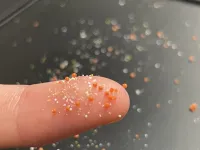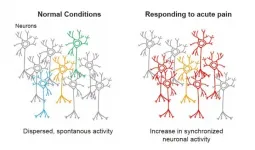(Press-News.org) WASHINGTON--People with type 1 diabetes can improve their blood sugar control while reducing time with low blood sugar, or hypoglycemia, using Insulet Corporation's Omnipod 5 Automated Insulin Delivery System compared to their standard insulin therapy. Results from an industry-sponsored study of the latest Omnipod, the first tubeless, wearable insulin pump, will be presented at ENDO 2021, the Endocrine Society's annual meeting.
The Omnipod 5 System underwent three months of at-home testing in 128 adults and adolescents ages 14 to 70 years and 112 children ages 6 to less than 14 years. All study participants have type 1 diabetes and were first followed for two weeks using their standard therapy, either multiple daily insulin injections or an insulin pump. Using Omnipod 5, participants experienced significant average improvements in both hemoglobin A1c, a measure of blood glucose (sugar) control over the past several months, and the percentage of time the participants stayed within the recommended target glucose range (70 to 180 milligrams per deciliter), the researchers reported.
"These study results represent an advancement in diabetes therapies with a fully wearable device that enables continuous automated insulin modulation. This will expand the available treatment options for people with type 1 diabetes," said the study's senior investigator, Trang Ly, MBBS, FRACP, PhD, Senior Vice President and Medical Director of Insulet Corporation.
Insulet funded this study and manufactures Omnipod 5, which is under review by the U.S. Food and Drug Administration. It is an update to the Omnipod DASH and the original Omnipod System, which are sold in the U.S., Canada, Europe and the Middle East.
The Omnipod 5 System, according to Ly, is the first tubeless automated insulin delivery system integrated with the Dexcom G6 continuous glucose monitoring (CGM) system. She said this commonly used glucose monitor automatically measures glucose levels every five minutes and communicates directly with Omnipod 5. The Pod is now designed with an embedded algorithm that adjusts the pump's insulin delivery automatically to a customizable glucose target, based on the CGM value and trend.
Users of Omnipod 5 inject insulin into a single-use Pod, which adheres to their skin for 72 hours of continuous infusion of insulin. At mealtimes, the user administers a bolus dose of insulin which is controlled by the Omnipod 5 app on the user's personal smartphone or a separate wireless controller. Ly said the new system will have the ability to control the Pod from a compatible smartphone, making the wireless controller optional.
Ly reported that the adult/adolescent group's A1c averaged 0.4 percent lower with Omnipod 5 than when they used their standard insulin therapy, an improvement from 7.2 percent to 6.8 percent.
With Omnipod 5, their average time in the glucose range recommended by the American Diabetes Association (70 to 180 milligrams per deciliter) was 2.2 hours a day longer, or 9.3 percent better, Ly stated. Overall, this group was in target range nearly 74 percent of the time when they used Omnipod 5, while the general population with type 1 diabetes is often in target glucose range 60 percent or less of the time.
"Even though many of the study participants had their diabetes well controlled before the study, they still experienced improved time in the target glucose range, regardless of their baseline control. This shows the potential of the technology in the broader population with diabetes," Ly said.
One of their most important findings in the adult/adolescent group, according to Ly, was a reduction of time in hypoglycemia, measured on the sensor as glucose levels below 70 milligrams per deciliter, down to a median of 1.1 percent. Hypoglycemia is a dangerous drop in blood glucose levels. Only two episodes of severe hypoglycemia occurred, reportedly after user-initiated bolus doses.
Most study participants chose to continue using the Omnipod 5 during an extension of the original three-month study, which Ly said suggests a preference over their previous therapy.
Children participating in the study also had improved blood sugar control after using Omnipod 5. The average A1c dropped by 0.7 percent, to 7 percent, and the time in range improved by nearly four hours per day. One event of diabetic ketoacidosis (excessive ketones in the blood due to insufficient insulin) occurred, which Ly attributed to infusion site failure. She said one severe hypoglycemia event occurred that was not attributable to device malfunction.
"Omnipod 5 protects you from both high and low glucose values," Ly said. "It also is simple, intuitive, and easy to use."
Sue Brown, M.D., of the University of Virginia in Charlottesville, Va., will present the data for adults and adolescents during an oral presentation at the meeting. Bruce Buckingham, M.D., of Stanford University, will present the pediatric data in a poster presentation.
INFORMATION:
Endocrinologists are at the core of solving the most pressing health problems of our time, from diabetes and obesity to infertility, bone health, and hormone-related cancers. The Endocrine Society is the world's oldest and largest organization of scientists devoted to hormone research and physicians who care for people with hormone-related conditions.
The Society has more than 18,000 members, including scientists, physicians, educators, nurses and students in 122 countries. To learn more about the Society and the field of endocrinology, visit our site at http://www.endocrine.org. Follow us on Twitter at @TheEndoSociety and @EndoMedia.
WASHINGTON--Higher levels of the stomach-derived hormone ghrelin, which stimulates appetite, predict a greater preference for smaller immediate monetary rewards over larger delayed financial rewards, a new study finds. The study results will be presented at ENDO 2021, the Endocrine Society's annual meeting.
This research presents novel evidence in humans that ghrelin, the so-called "hunger hormone," affects monetary decision making, said co-investigator Franziska Plessow, Ph.D., assistant professor of medicine at Massachusetts General Hospital and Harvard Medical School, Boston. She said recent research findings in rodents suggested that ghrelin may play a part in impulsive choices and behaviors.
"Our results indicate that ghrelin might play a broader role than ...
WASHINGTON--Nearly one in five U.S. children and teenagers has obesity, and statistics show a higher prevalence of obesity in certain ethnicities, such as Hispanics and Blacks. Now results of a study being presented at ENDO 2021, the Endocrine Society's annual meeting, suggest that Spanish as a family's primary language is a predictor of childhood obesity, regardless of ethnicity.
The prevalence of obesity among children and teens from Spanish-speaking households in the nation was 24.4 percent, approximately 50 percent higher than those from English-speaking households, according to results of a new analysis of the U.S. National Health and Nutrition Examination Survey. This survey examines a nationally representative sample ...
Tokyo, Japan - Researchers from Tokyo Metropolitan University have devised and implemented a simplified algorithm for turning freely drawn lines into holograms on a standard desktop CPU. They dramatically cut down the computational cost and power consumption of algorithms that require dedicated hardware. It is fast enough to convert writing into lines in real-time, and makes crisp, clear images that meet industry standards. Potential applications include hand-written remote instructions superimposed on landscapes and workbenches.
Flying cars, robots, spaceships...whatever sci-fi future you can imagine, there is always a common feature: holograms. ...
Researchers from Columbia University and Temple University published a new paper in the Journal of Marketing that examines how choice architecture can reduce socioeconomic disparities.
The study, forthcoming in the Journal of Marketing, is titled "Do Nudges Reduce Disparities? Choice Architecture Compensates for Low Consumer Knowledge" and is authored by Kellen Mrkva, Nathaniel Posner, Crystal Reeck, and Eric Johnson.
As Mrkva explains, "Our research demonstrates that people with low socioeconomic status (SES), low numerical ability, and low knowledge are most impacted by nudges. As a result, 'good nudges,' designed to encourage ...
It's estimated that an average-sized wastewater treatment plant serving roughly 400,000 residents will discharge up to 2,000,000 microplastic particles into the environment each day. Yet, researchers are still learning the environmental and human health impact of these ultra-fine plastic particles, less than 5 millimeters in length, found in everything from cosmetics, toothpaste and clothing microfibers, to our food, air and drinking water.
Now, researchers at New Jersey Institute of Technology have shown that ubiquitous microplastics can become 'hubs' for antibiotic-resistant bacteria ...
ROCHESTER, Minn. -- Low representation of minority groups in public genomic databases may affect therapy selection for Black patients with cancer, according to new Mayo Clinic research published in npj Precision Oncology.
The researchers investigated the use of genomic databases and found that tumor mutation burden was significantly inflated in Black patients compared to White patients.
As a result of the study, clinicians who are using public genomic databases need to be aware of the potential for inflated tumor mutation burden values and how that may affect therapy selection and outcomes, especially for patients from underrepresented groups.
Clinicians use biomarkers, which are indicators of a disease or condition, to determine ...
BOSTON - Researchers have used a genetic engineering strategy to dramatically reduce levels of tau--a key protein that accumulates and becomes tangled in the brain during the development of Alzheimer's disease--in an animal model of the condition. The results, which come from investigators at Massachusetts General Hospital (MGH) and Sangamo Therapeutics Inc., could lead to a potentially promising treatment for patients with this devastating illness.
As described in Science Advances, the strategy involves a gene regulation technology called zinc finger protein transcription ...
A team of scientists, led by researchers at Northwestern University, Shirley Ryan AbilityLab and the University of Illinois at Chicago (UIC), has developed novel technology promising to increase understanding of how brains develop, and offer answers on repairing brains in the wake of neurotrauma and neurodegenerative diseases.
Their research is the first to combine the most sophisticated 3-D bioelectronic systems with highly advanced 3-D human neural cultures. The goal is to enable precise studies of how human brain circuits develop and repair themselves in vitro. The study is the cover story for ...
In a world first, a cross-institutional research collaboration has used a two-photon microscope (*1) with a combination of calcium imaging (*2) and holographic stimulation (*3) to reveal that the functional connectivity between neurons located in the primary somatosensory cortex is increased in response to acute pain.
Pain occurs as a result of injury, such as peripheral neuron damage or inflammation stemming from peripheral tissue violation. Research findings have been published on the involvement of central nervous system abnormalities in the onset of pain and sustained pain. The primary somatosensory cortex ...
COLUMBUS, Ohio - Most stroke victims don't receive treatment fast enough to prevent brain damage. Scientists at The Ohio State University Wexner Medical Center, College of Engineering and College of Medicine have developed technology to "retrain" cells to help repair damaged brain tissue. It's an advancement that may someday help patients regain speech, cognition and motor function, even when administered days after an ischemic stroke.
Engineering and medical researchers use a process created by Ohio State called tissue nanotransfection (TNT) to introduce genetic material into cells. This allows them to reprogram skin cells to become something ...


